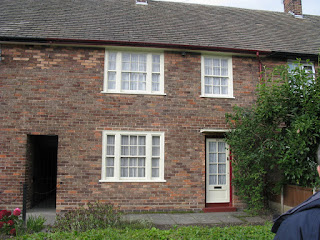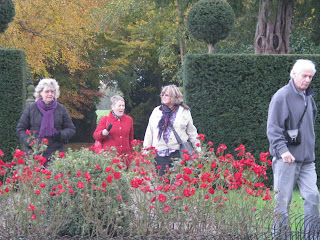Starting my first blog ever from the beginning of May 2010,bringing all our families together, keeping it simple on holidays,journeys,family,music,footy,videos,images and general chit chat - Hope you like it - From the Evans Family home in Stafford and Filitz Family Near Hameln Germany xxxx
19/12/2010
13/11/2010
FUHLEN TRIP - EARLY NOVEMBER 2010





31/10/2010
ERDIGG - WRECSAM - NATIONAL TRUST VISIT SATURDAY 30TH OCTOBER



We decided to meet Wendy, Val and Jeremy at the National Trust ERDIGG near Wrecsam, it was a great Autumn day, there was a special Halloween Festival on. We all took a picnic,we all thought the house was a wonderfull recovery by the National Trust to capture the early workings of this jewel in the crown. We finally ended up with a lovely scrummy pub meal on route home.Herewith a history of ERDIGG WRECSAM.
When Joshua Edisbury was appointed as High Sheriff of Denbighshire, he decided to build a grand, new house more befitting of his status than the humble family home in which he was raised. A mile outside of Wrexham, the building of Erddig began in 1684 to the designs of Thomas Webb, and has survived with remarkably little structural change to the main core of the house. Edisbury's extravagant plans for the house, combined with his diminishing resources, eventually bankrupted him, causing him to leave Erddig, and Wales. Subsequently being purchased by John Meller, a wealthy barrister and bachelor, Erdigg remained in the family for the next 250 years or so. Extended by new wings at either end of the building to provide a Chapel and additional dressing rooms, Meller then installed many pieces of fine furniture to complete his now lavishly decorated new home.
Philip Yorke, the great nephew of Meller, and his wife Elizabeth, unarguably had the most impact on Erddig, altering the front elevation of the house, remodelling and refurbishing many of the rooms, and reorganising the estate. Among his many pursuits and interests, Philip was a dedicated historian with a developing interest in the lives of everyday people. The servants and estate workers at Erddig were always highly thought of by the Yorke family, and this relationship is amusingly demonstrated in some of Philip's artistic work. It was he who started the unusual tradition of having the servants painted, and these pictures would be accompanied by quirky little ditties composed by Philip. Many of these delightful paintings can now be seen hanging in the servants' hall and along the corridor.
During the early 19th century a large, Regency dining room was created by Philip's son and heir, Simon, and this was the last major work undertaken at Erddig, although regular maintenance of the family treasures continued. Every member of the family that lived in this vast country house had an undeniable appreciation for its history and its treasures, each in turn preserving and restoring whatever required attention. Despite this, Erdigg became severely run down after the First World War and, without sufficient money, and the onset of the Second World War, the situation deteriorated further.
The final straw came when the coal industry was nationalised in 1947, effectively taking away the estate's major source of income, and this was immediately followed by the National Coal Board's decision to mine directly under the house, compounding its declining structural state. It was only through grit and determination, not to mention some small measure of eccentricity on the part of the last two Yorke brothers, that Erddig has survived so remarkably intact.
Set in very picturesque grounds, this fascinating house of contrasts is an absolute delight to explore. Unlike many great country homes and manor houses filled with priceless art collections and exquisite furnishings, Erddig is just crammed full of treasures that say more about the different personalities of the family members.
One thing they all certainly had in common was the fact that none of them liked to throw anything away, however worthless or insignificant the article might have seemed at the time, and this adds immensely to the interest. The National Trust have recently made the attic rooms accessible and these really are the place to indulge in a good rummage around the assorted paraphernalia of a bygone era.
22/10/2010
TRIP TO PENRYN CASTLE BANGOR NORTH WALES - NATIONAL TRUST


 We decided to take a trip to the National Trust Penryn Castle near Bangor on Sunday 17th October 2010, the weather stayed very sunny then clouded over later.
We decided to take a trip to the National Trust Penryn Castle near Bangor on Sunday 17th October 2010, the weather stayed very sunny then clouded over later.03/10/2010
BIRDING ON THE WIRRAL- SUNDAY 3RD OCTOBER 2010
 Decided to go bird watching on the Dee Estuary at RSPB Inner Marsh Farm along the front at Parkgate,Hoylake and New Brighton. The weather was very poor heavy rain from early doors till 2.30pm, after that the weather was sunny. Birds seen on the day,Little Stints,Spotted Redshank,Redshank, Black Tailed Godwits, Curlew, Oystercatchers, Dunlin, Black Tern,Gannets,Greenshank,Shovelers,Mute Swans
Decided to go bird watching on the Dee Estuary at RSPB Inner Marsh Farm along the front at Parkgate,Hoylake and New Brighton. The weather was very poor heavy rain from early doors till 2.30pm, after that the weather was sunny. Birds seen on the day,Little Stints,Spotted Redshank,Redshank, Black Tailed Godwits, Curlew, Oystercatchers, Dunlin, Black Tern,Gannets,Greenshank,Shovelers,Mute Swans27/09/2010
SPEKE HALL AND JOHN LENNONS AND PAUL MCCARTNEYS CHILD HOOD HOMES - SUNDAY 26TH SEPTEMBER 2010

Paul McCartneys House Liverpool

VERY MIDDLE CLASS HOME

MENDIPS - HOME OF JOHN LENNON

ARRIVING FOR THE HOUSE TOUR

AT THE HOUSE-WAITING FOR THE GUIDE AT 12.30PM
 We planned this visit as Annie Cullen, was over from France for 10days. We all met at Wendy and Tonys house in Alsager on the sunday morning. We all had prepared a picnic, the weather was cold but very sunny. We arrived at Speke Hall, parked up and started the tour with a warm coffee inside our bellies, then we booked a guided tour, which was very interesting and homely, well worth the trip up the M6/M56.We decided to have our lunch at Speke Hall before departing for John Lennons and Paul McCartneys childhood houses.
We planned this visit as Annie Cullen, was over from France for 10days. We all met at Wendy and Tonys house in Alsager on the sunday morning. We all had prepared a picnic, the weather was cold but very sunny. We arrived at Speke Hall, parked up and started the tour with a warm coffee inside our bellies, then we booked a guided tour, which was very interesting and homely, well worth the trip up the M6/M56.We decided to have our lunch at Speke Hall before departing for John Lennons and Paul McCartneys childhood houses. 26/09/2010
VICKYS 30TH BIRTHDAY PARTY FRIDAY 24TH SEPT 2010

19/09/2010
STARSOUND - NEW BAND FROM STOKE
Black velvet 92BPM
Don’t speak 76BPM HALF TEMPO
I want to break free 110BPM
Dog Days/ You got the love 150BPM
Crazy 112BPM
Superstition 100BPM
Maria 160BPM
Valerie 84BPM HALF TEMPO
Son of a Preacher Man 90BPM
Who Knew 140BPM
Sweet child o’ mine 126BPM
With or without you 110BPM
I need a hero 150BPM
Kids in America 160BPM
Living on a prayer 122BPM
Mercy 130BPM
Poker Face 120BPM
Brown Eyed Girl 150BPM
Jump 132BPM
Sex on fire 154BPM
I saw her standing there 162BPM
Twist and shout 128BPM
Take on me 168BPM
Don’t stop me now 156BPM
14/09/2010
NAT AND KIDS UK VISIT 8TH TO 15TH SEPTEMBER 2010

Watching the little monkeys

Anna with her Mum at Kent way

Group shot at Beaumaris Anglesey

Oliver happy in the water as ever.
SATURDAY - Day out with the kids to the Britannia Stadium, My Mums, Monkey Forest,while Nat and Cynth has some retail therapy in Birmingham
WEDNESDAY -Just locally getting ready for flight back to Hannover, called at my Mums on the way to Manchester, Nat arrived home at 2.45am due to late take off from Manchester.
05/09/2010
DAY TRIP TO THE ISLE OF ANGLESEY - 4TH SEPTEMBER 2010
The name Anglesey is thought to have come from a Viking place name. In old Norse the -ey ending indicates an island named after a particular person (cf. Bardsey, Orkney, Ramsey, etc.). Anglesey is probably derived from "Ongl's ey", Ongl's island. Who Ongl was we have no idea. To see a BBC video clip about the origin of the name of Anglesey click here.
This site now has a major new section on the Windmills of Anglesey.
Today it has several thriving towns. The historic town of Beaumaris is the site of one of the castles built by Edward I after his defeat of the Welsh princes, as well as the historic mansion Henllys Hall, now a hotel (see their pages for more on the history of Anglesey and Wales). The town of Holyhead, on Holy Island, is the main ferry port for travel across the Irish Sea to Dublin and Llangefni, in the centre of the island, is the county town. Kovach Computing Services (the host of this site) is located in the village of Pentraeth.
Anglesey also has the village with the longest place name in Britain: Llanfairpwllgwyngyllgogerychwyrndrobwllllantysiliogogogoch (click here to hear it pronounced). The name, when translated into English, means "The church of St. Mary in a hollow of white hazel near a rapid whirlpool and near St. Tysilio's church by the red cave". The name was actually coined in the nineteenth century to attract tourists to the Island. It is abbreviated to Llanfairpwll or Llanfair P.G. by the locals.

Red Wharf Bay at low tide, picking moules, we saw curlew, oystercatchers, cormorant, little egret, LB B Gulls, GBB Gulls.


Beaumaris Water Front
 Gareth and Sali organised a visit to the Isle of Anglesey to see her Great Grandmothers Family Grave on the Island, they asked did we want to come so we said yes. Gareth and Sali stayed overnite with us for an early 7.45am start. We met up with Gavin and Linda at Stafford North Services on the M6 Motorway. The weather looked good with showers late afternoon.
Gareth and Sali organised a visit to the Isle of Anglesey to see her Great Grandmothers Family Grave on the Island, they asked did we want to come so we said yes. Gareth and Sali stayed overnite with us for an early 7.45am start. We met up with Gavin and Linda at Stafford North Services on the M6 Motorway. The weather looked good with showers late afternoon. 





















